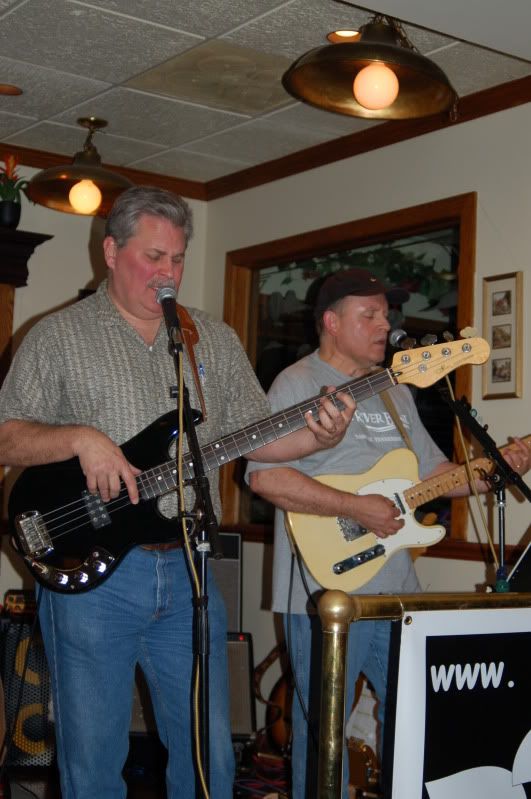I think I'm hankering for a gyro and fries today. Not the best dietary decision I'll make all week, but what kind of life is it if you don't allow yourself something delicious and fattening now and then? There's a great little hole-in-wall-joint nearby that I think makes the best gyros in town. The proprietor has a demeanor that's just a notch or two below Seinfeld's soup Nazi character, but you can't argue with the flavor. Anyway, I enjoy the occasional surly service. Reminds me of a real diner.
Today's visual comes to us compliments of my beloved L-1000s (again, apologies for the less than optimal photo quality):

The model on the left is a 1980 hog/ebony with what is apparently a not so common clear red finish. It sports a fair amount of honest play wear and was less than ideally maintained until I got my mitts on it. The ebony board was pretty thirsty and had a couple of small hairline cracks that I remedied with some #20 black super glue from Stew-Mac (I didn't know this stuff existed until I consulted support to inquire what they'd recommend). Not a lightweight, but a genuine tone monster. This one has gotten a lot of love since I bought it a bit less than two years ago.
The ash model to the right is an '81 with the characteristic slot pole pieces. She sports what I'm about 95% sure is a Macassar ebony board. If it's rosewood, it's unlike any variety I've ever seen as it's extremely hard (no telltale round wound treads) and smooth with a very tight grain resembling that of her hog sister. This one is nice and light and, aside from some finish checking and wear to the chrome on the tuning pegs, in outstanding condition. This one is string with Chromes whereas the other wears D'Addario rounds, which provides a bit of tonal distinction between the two.
I think the L-1000 is my favorite of all bass models I've ever played. I think Leo set out with this design to create the ultimate P bass, and I think he succeeded with flying colors. I'm crazy about the separate (completely passive) treble and bass controls and the coil switching is absolutely to die for. In humbucker mode, they're nice and quiet, round and full. In the middle coil tap mode they can cop that 50s single coil P sound and the OMG (or single coil + bass boost) mode speaks for itself. I don't think there's a bigger sounding passive bass out there, or if there is, I have yet to run across it. I've confounded multiple bass player friends with the information that there's no active circuitry in these things. They have to be heard to be believed.
G&L related topic for the day: Of all the wood combinations past and present, which is your favorite? Seems that the hog/ebony match-up is pretty popular, but I wonder if part of that is due to the fact that these woods are also the most uncommon. For you hog/ebony lovers out there, is it the tone you love, or is it an aesthetic thing? For that matter, in general, are you drawn to a particular wood because of how it sounds/resonates or maybe just because you like the look? I'll confess, to me it's a bit of both because I don't put quite as much stock in the whole "tone woods" debate as some do. I tend to think the mass of the wood, which can vary a great deal even from stuff cut from the same tree, has more to do with it than species. But what do I know?
Non G&L discussion topic: At a recent gig I had the unprecedented experience of having an amp head die on me. It was probably the most jarring technical setback I've experienced in some 15 years of regular gigging. What's the worst technical SNAFU you've ever had to deal with and how did you overcome it? (In my case, we were gigging with some friends' band and the bassist was right there with his head to bail me out.) Do y'all typically drag a backup head/amp to the gig, or do you take your chances? I confess, I never figured it terribly necessary until this past gig, but now I'm reconsidering my cavalier attitude.
Until tomorrow,
Fats
